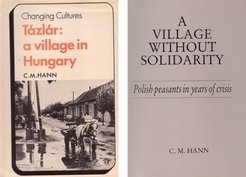Comparisons - Central European Villages Repeatedly Visited
This contrast, which I summarized at the end of my Polish monograph (1985), called a simple notion of property into question. Despite the loss of private property rights over land, the Hungarian system seemed to be working more efficiently from an economic point of view. Despite the political convulsion of 1956, villagers in Hungary were less disaffected from their political system and better integrated into the national society. This ebullience was evident to most foreign visitors to Hungary in this period.
In Poland, in contrast, the failure to tackle collectivization after 1956 led to a political stalemate. The consequences could be observed not only in remote villages such as Wislok, but all over the country as the Solidarity movement, together with the Roman Catholic Church, struggled to topple the socialist system. I titled my book Village without Solidarity because, contrary to the popular images of a united social movement, in this village I found little evidence of cohesion in any sphere other than the religious.

The prominence given to property reform in the post-socialist years led me to look at this topic again, first in the context of decollectivisation in Tázlár (1993) and later more generally (1998). Attitudes and identities bound up with land continue to play a significant role, especially among the older generation, while younger villagers tend to pay more attention to the negative economic prospects for the agricultural sector, and therefore to be reluctant to commit themselves to family-farming. Following Malinowski, I argued that land tenure has to be set in the wider context of 'citizenship' (1996) and 'entitlements' (1998). I stressed the political dimension of the new property relationships taking shape throughout the postsocialist world. Although China is not (yet) officially postsocialist, I tried to examine similar issues concerning property, economic efficiency and social identity during fieldwork in Xinjiang in 1996 (Hann 1999a). An outline comparison of all three field sites, Hungary, Poland and Xinjiang, on the basis of a broad, inclusive notion of property, can be found in Hann 1999b.
